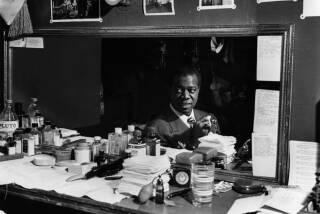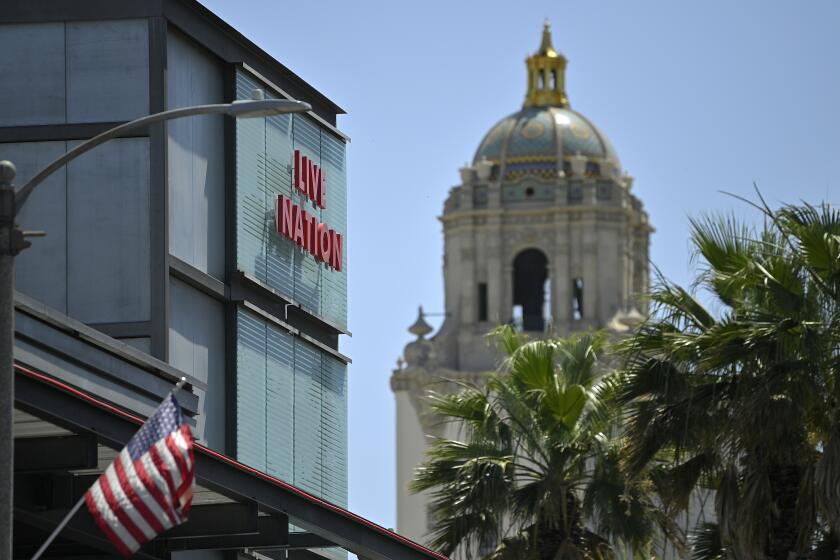SAN DIEGO COUNTY : Comeback Fever’s Got Ahold of Gene Pitney
- Share via
SAN DIEGO — Rock ‘n’ roll never forgets--but all too often, as the music-biz axiom goes, “it’s not the singer, it’s the song.”
So, at a time when many of today’s stars are reworking the old songs and getting them back on the charts, it’s gratifying to know that a select few are, instead, working with the old singers--and helping get them back on the charts as well.
In 1981, it was Bruce Springsteen, writing and producing “This Little Girl” for Gary U.S. Bonds. In 1986, it was Eddie Money dueting with Ronnie Spector on “Take Me Home Tonight.” Earlier this year, it was the Art of Noise, tapping Tom Jones to sing lead on “Kiss” and star in the accompanying video.
And now it’s Marc Almond, formerly with British techno-pop duo Soft Cell, pairing up with Gene Pitney for a remake of the romantic pop balladeer’s 1968 song “Something Got Ahold of My Heart.”
“It’s one of the most bizarre things that ever happened to me in my almost 30 years in the business,” said Pitney, whose Sunday night double-header at Humphrey’s on Shelter Island marks his first San Diego appearance in nearly two decades.
“When my agent first called me to ask whether I wanted to do (the remake), I almost turned it down,” Pitney recalled. “I had no idea who the guy (Almond) was. But then I said to myself, ‘Wait a minute--these are the kinds of things that always work best for me, these off-the-wall things.’
“So I ended up going to London and re-recording the song, and then Marc went into the studio to record his version of the song. And the next thing I knew, I was listening to the finished product.
“The producers and the engineers had chopped up my version and his version into a duet, and let me tell you, they did one hell of a job. I really loved how they updated it--it was a little faster, and they had added a lot of nice touches to it.
“And vocally, we really complemented each other.”
The remake of “Something Got Ahold Of My Heart,” with Pitney and Almond alternating on lead vocals, is scheduled for release next month by Capitol Records. So is the video, which was shot in a Las Vegas “junkyard for neon lights,” Pitney said.
“The premise of the video is that Marc had come to Las Vegas to see me perform, and by the end of the song we’re singing together on this stage set up smack in the middle of the junkyard, surrounded by hot-wired neon lights,” Pitney said.
“It’s an absolute study in contrasts: There’s Marc, with his slicked-back black hair, black-leather jacket, faded black jeans, and black boots, and then there’s me, with salt-and-pepper gray hair and wearing a tuxedo.
“We make a real odd couple. But the record company fell in love with it, and they’re convinced it’s going to be a really big hit.”
Pitney, now 48, sure could use “a really big hit.” After all, he hasn’t had one since 1968’s “She’s a Heartbreaker,” the last in a seven-year string of 16 Top 40 records that included such classics as “Town Without Pity,” “(The Man Who Shot) Liberty Valance,” “Only Love Can Break a Heart,” “It Hurts to Be in Love,” and “I’m Gonna Be Strong.”
But even if the song doesn’t catch on, said Pitney--who also established himself as a songwriter responsible for such hits as “Rubber Ball” for Bobby Vee, “Hello Mary Lou” for Ricky Nelson, and “He’s a Rebel” for the Crystals before and during his own assault on the charts beginning in 1961 with “(I Wanna) Love My Life Away)”--he’s content to continue plying the oldies circuit in the United States, as he’s done since 1985, after a self-imposed exile of 15 years.
“Back in 1970, I left my own back yard because of a tax dispute,” Pitney said. “Until then, I had been traveling about 11 months out of the year, maintaining my residence in Connecticut and my business in New York.
“The state tax in Connecticut is a lot lower than it is in New York, and one day my accountant told me that the rules had been changed--that unless I established my domicile in Connecticut by spending at least six months a year at home, I would be subject to the higher New York rate.
“So I was essentially forced to cut back to six months of touring, and that meant choosing between the United States and overseas.
“And I have to admit, by that time I had done enough of those Dick Clark package tours through Peoria and Cincinnati that I was more than willing to restrict my concert appearances to faraway places where I could still headline on my own, like London, Milan, Rome, Paris and Sydney.”
So, throughout the 1970s and early ‘80s, Pitney said, he would tour Europe in the fall, come home for the winter, tour Japan, Australia, and New Zealand in the spring, and come home again for the summer.
But four years ago, the success of a trial 15-date “comeback” tour prompted Pitney to resume touring the United States on a regular basis.
“The thing I had always liked best about touring abroad was constantly running into different people, different cultures, different foods,” he said. “It really pumped up my batteries.
“But now, the whole world has become so Westernized that one out of every two people speaks English, and there’s a McDonald’s on every corner.”
In addition, Pitney added, “when I came back to the United States, it wasn’t like before, when I was on those Dick Clark packages and rarely played more than four songs.”
“I was finally able to do a whole hour-and-a-half show by myself and really be a performer, just as I had been doing abroad,” he said. “And after being gone for so long, playing in the U.S. was almost like playing in a different country; after 15 years, it was a really strange and unique experience.”
It’s still a “strange and unique experience” today, Pitney says.
“I’m constantly playing to a demographically diverse audience--not just the older people who remember me, but a lot of younger people, a lot of kids,” he said.
“I remember asking one young fan a few weeks ago, ‘I haven’t had a hit in years, so why are you here?’ And he told me, ‘To see what you’re all about.’
“And what that tells me is that all this airplay that the stuff from the 1950s and ‘60s has been getting in recent years has resulted in people like me attracting two generations of fans.
“One generation is driven by nostalgia, the next by curiosity. And that’s why I have no plans to retire--I’m enjoying myself much too much to even think about giving up.”
More to Read
The biggest entertainment stories
Get our big stories about Hollywood, film, television, music, arts, culture and more right in your inbox as soon as they publish.
You may occasionally receive promotional content from the Los Angeles Times.










